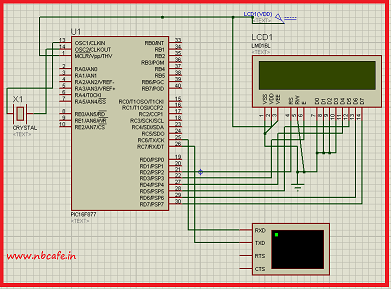

- #UART EMBEDDED C PROGRAM SERIAL#
- #UART EMBEDDED C PROGRAM MANUAL#
- #UART EMBEDDED C PROGRAM SOFTWARE#
- #UART EMBEDDED C PROGRAM PC#
Add a label to the start of the string that your program can access. Find the ASCII values for the letters in your name, create a data section in your program, and add the ASCII values to the data section as a sequence of consecutive bytes (be sure to include an all-zero byte at the end). Using your name, create a string of characters that your program can transmit. A null-terminated string is simply a character string with the last character being zero. Write a program capable of transmitting null-terminated strings (also known as c strings). Use null-terminated strings to send a sequence of characters When an LEDs state is changed, send the number of the LED that was toggled to the PC’s terminal. If a ‘b’ is received, toggle LED1, if a ‘c’, toggle LED2, and if a ‘d’ toggle LED3. If an ‘a’ is received, toggle LED0 to its opposite state. Write a program that uses your read subroutine to receive a character from the UART port.

When data is available, read it, and pass it back to the calling program. Once called, the subroutine can check the FIFO status, and wait until there is at least one entry in the receive FIFO. Write an assembly subroutine to read a character from the UART port. Mov r0, #70 ascii 'F' to r0 bl uart1_send_char the data in r0 over uart b. Here is an example program structure: main: Make sure you check the UART FIFO transmit status before placing the data in the FIFO, and wait for it to be ‘not full’ before writing to the UART FIFO.

To send the character, write a function that takes in a one-byte ASCII character as a parameter. When you run the program, the sent character should appear on the Vitis terminal. After sending the character, enter an endless loop.
#UART EMBEDDED C PROGRAM PC#
After configuring the UART, send a character to your PC by writing an ASCII character to the UART data FIFO.
#UART EMBEDDED C PROGRAM MANUAL#
Write a function that configures the Zynq’s UART 1 module for 115200 baud, 8 data bits, one stop bit, and no parity (refer to the reference manual page to learn which registers must be programmed). Send a character from the Blackboard to a PC
#UART EMBEDDED C PROGRAM SERIAL#
UARTs and Serial Ports ZYNQ’s UART Controllers UART Functions Assembly Data Segments Embedded C Primer UART Assembly Tutorial Requirements 1. Once you can successfully send and receive data from your C program, you can easily use the UART in future projects to move data between your Blackboard programs and a PC.
#UART EMBEDDED C PROGRAM SOFTWARE#
Characters typed into the terminal window are immediately sent out the UART port, and characters received from the UART port are immediately displayed in the same window.Īfter your basic UART communications software is working, you will write a simple C program to call your assembly-language subroutines. Terminal programs let you interact in real-time with a PC’s serial/UART port, and they have been a part of PC operating systems from the very beginning. On the PC side, you can use a “terminal program" to communicate with the UART channel (a suitable terminal program is built in to Vitis). In this project, you will write an assembly language program to transfer data between the Blackboard and a PC using one of ZYNQ’s UART ports. The Blackboard uses one UART port to move data between the Bluetooth/WIFI ESP32 radio and the ZYNQ chip, and a second UART port to move data between the ZYNQ and a USB-connected PC (using “UART over USB”). Nevertheless, because they are simple and low cost, many devices still support them, and many systems still include them. In the last 20 years, they have been superseded by USB (or wireless) ports for inter-device communications, and by I2C or SPI ports for on-board communications. They were also widely used inside the computer to connect time-of-day clocks, temperature sensors, small displays, and other devices to the CPU. From the 1970’s until the early 2000’s, they were built in to virtually every computer system, and they were used for connecting external devices like mice, keyboards, modems, scanners, printers, and many other after-market devices. They are simple and efficient, and widely available and inexpensive, but they are also relatively low performance. UART ports were among the first data ports ever used in computer systems, and they haven’t changed much in more than 50 years.


 0 kommentar(er)
0 kommentar(er)
